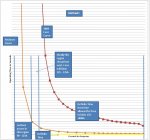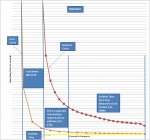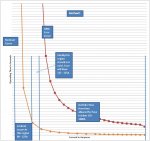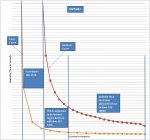kenth619
Member
- Location
- United States
Good day,
I am brainstorming a coordination problem whereby the inverse time overcurrent lowsetset pickup of an autorecloser has to be set for a 12kV feeder. The feeder has a small load of about 60A max expected. The smallest branch circuit fuse is the 20A K type Chance fuse with minimum melting pickup of 40A. The largest section (trunk) fuse is the 50A K type Chance fuse with minimum melting pickup of 100A. The feeder conductor is rated at 357A.
The question is should the lowset time overcurrent pickup be set based on the ampacity of the feeder conductor (357A) or based on the max expected load that the feeder is expected to have (just above 60A)? Two POCO engineers are giving me different answers.
(1)One is saying that the pickup should be just above 60A (about 90A to be exact) to check for overload, in which case the autorecloser will lockout after a sufficient amount of time (overload protection) without fuse operation. The definite time pickup is set at 1.5 times this pickup (135A) to discriminate between fault currents and overload and the definite time is set at 0 seconds so that on first trip for faults 135A and above the auto responds to the fault first before the fuse can blow. After reclosing if the fault persists the time overcurrent element is used to allow the fuse sufficient time to blow.
Disadvantage: with this method, the feeder is being limited to below its max rated current. There is the possibility of locking out the feeder below the max current the feeder can handle (between 90A and 100A)
Advantage: with this method, overload protection is possible as the pickup is set just above the max expected load current.
(2)The other engineer is saying that the fault levels are independent of the load current on the feeder and is only dependant on impedance from the generator down to the 12kV level. This means that although the feeder is serving a small load, there can still be fault currents of the order of thousands of amps. Also he is saying that the autorecloser's purpose is really to protect the feeder. Hence the lowset should be set at 357A the rated ampacity of the conductor. The definite time pickup should be set at 1.5 times this value (535A) for discrimination. The definite time is set at 0 seconds so that on first trip for faults 535A and above the auto responds to the fault first before the fuse can blow. After reclosing if the fault persists the time overcurrent element is used to allow the fuse sufficient time to blow.
Disadvantage: with this method, one can see that there will never be overload protection because the load is much smaller than the ampacity of the conductor.
Advantage: with this method, the feeder is not being limited to below what it can handle.
Method 2 has been implemented and the auto is tripping and reclosing before fuses melt for faults 535A and above. But I can't get over this feeling that for faults below 357A the fuses will blow. Most faults do occur at around 500A - 600A but in the last few days fuses have been blowing often. In some instances, the autorecloser operated before the fuse but there are more fuse blowing occurences than autorecloser operations. I would like an expert opinion on this please and if method 1 is to be used, should the 90A pickup be used (how is the pickup selected based on largest truck fuse and smallest branch fuse pickup)?
I am brainstorming a coordination problem whereby the inverse time overcurrent lowsetset pickup of an autorecloser has to be set for a 12kV feeder. The feeder has a small load of about 60A max expected. The smallest branch circuit fuse is the 20A K type Chance fuse with minimum melting pickup of 40A. The largest section (trunk) fuse is the 50A K type Chance fuse with minimum melting pickup of 100A. The feeder conductor is rated at 357A.
The question is should the lowset time overcurrent pickup be set based on the ampacity of the feeder conductor (357A) or based on the max expected load that the feeder is expected to have (just above 60A)? Two POCO engineers are giving me different answers.
(1)One is saying that the pickup should be just above 60A (about 90A to be exact) to check for overload, in which case the autorecloser will lockout after a sufficient amount of time (overload protection) without fuse operation. The definite time pickup is set at 1.5 times this pickup (135A) to discriminate between fault currents and overload and the definite time is set at 0 seconds so that on first trip for faults 135A and above the auto responds to the fault first before the fuse can blow. After reclosing if the fault persists the time overcurrent element is used to allow the fuse sufficient time to blow.
Disadvantage: with this method, the feeder is being limited to below its max rated current. There is the possibility of locking out the feeder below the max current the feeder can handle (between 90A and 100A)
Advantage: with this method, overload protection is possible as the pickup is set just above the max expected load current.
(2)The other engineer is saying that the fault levels are independent of the load current on the feeder and is only dependant on impedance from the generator down to the 12kV level. This means that although the feeder is serving a small load, there can still be fault currents of the order of thousands of amps. Also he is saying that the autorecloser's purpose is really to protect the feeder. Hence the lowset should be set at 357A the rated ampacity of the conductor. The definite time pickup should be set at 1.5 times this value (535A) for discrimination. The definite time is set at 0 seconds so that on first trip for faults 535A and above the auto responds to the fault first before the fuse can blow. After reclosing if the fault persists the time overcurrent element is used to allow the fuse sufficient time to blow.
Disadvantage: with this method, one can see that there will never be overload protection because the load is much smaller than the ampacity of the conductor.
Advantage: with this method, the feeder is not being limited to below what it can handle.
Method 2 has been implemented and the auto is tripping and reclosing before fuses melt for faults 535A and above. But I can't get over this feeling that for faults below 357A the fuses will blow. Most faults do occur at around 500A - 600A but in the last few days fuses have been blowing often. In some instances, the autorecloser operated before the fuse but there are more fuse blowing occurences than autorecloser operations. I would like an expert opinion on this please and if method 1 is to be used, should the 90A pickup be used (how is the pickup selected based on largest truck fuse and smallest branch fuse pickup)?
Last edited:





